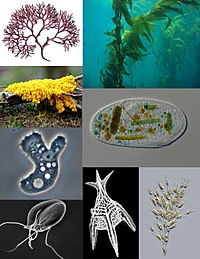
Photo from wikipedia
Soil protists are increasingly studied due to a release from previous methodological constraints and the acknowledgement of their immense diversity and functional importance in ecosystems. However, these studies often lack… Click to show full abstract
Soil protists are increasingly studied due to a release from previous methodological constraints and the acknowledgement of their immense diversity and functional importance in ecosystems. However, these studies often lack sufficient depth in knowledge, which is visible in the form of falsely used terms and false- or over-interpreted data with conclusions that cannot be drawn from the data obtained. As we welcome that also non-experts include protists in their still mostly bacterial and/or fungal-focused studies, our aim here is to help avoid some common errors. We provide suggestions for current terms to use when working on soil protists, like protist instead of protozoa, predator instead of grazer, microorganisms rather than microflora and other terms to be used to describe the prey spectrum of protists. We then highlight some dos and don'ts in soil protist ecology including challenges related to interpreting 18S rRNA gene amplicon sequencing data. We caution against the use of standard bioinformatic settings optimized for bacteria and the uncritical reliance on incomplete and partly erroneous reference databases. We also show why causal inferences cannot be drawn from sequence-based correlation analyses or any sampling/monitoring, study in the field without thorough experimental confirmation and sound understanding of the biology of taxa. Together, we envision this work to help non-experts to more easily include protists in their soil ecology analyses and obtain more reliable interpretations from their protist data and other biodiversity data that, in the end, will contribute to a better understanding of soil ecology.
Journal Title: Molecular ecology resources
Year Published: 2023
Link to full text (if available)
Share on Social Media: Sign Up to like & get
recommendations!